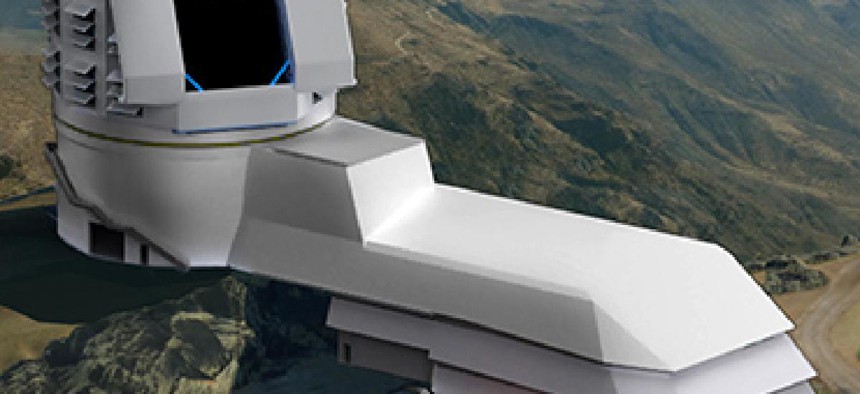Largest digital camera ever will be pointed at the sky

The Large Synoptic Survey Telescope 'will help researchers study the formation of galaxies, track potentially hazardous asteroids, observe exploding stars and better understand dark matter and dark energy.'

Rendering of the Large Synoptic Survey Telescope observatory atop Cerro Pachón in Chile. The LSST will produce the widest, deepest and fastest views of the night sky ever observed. (Image courtesy of Large Synoptic Survey Telescope Project Office)
One of the Energy Department's national research laboratories is only a step away from beginning the construction phase of a telescope facility that will house a huge stargazing digital camera capable of seeing billions of space objects and generating millions of gigabytes of data for public consumption.
On Jan. 9, DOE gave its SLAC National Accelerator Laboratory, operated by Stanford University in Menlo Park, Calif., the nod to begin the next step of development for the 3,200-megapixel camera that is the centerpiece of the Large Synoptic Survey Telescope.
Lab officials said the three-ton, automobile-sized camera will be the largest digital camera ever built. It will be eventually be housed in a new observatory complex high in the Chilean mountains, where it will have a clear view of the southern sky to better gather images and data from far-flung sectors of the universe.
The $700 million telescope project is due for completion by 2022.
A statement from SLAC said the LSST could produce "an unprecedented archive of astronomical data that will help researchers study the formation of galaxies, track potentially hazardous asteroids, observe exploding stars, and better understand mysterious dark matter and dark energy."
SLAC said the LSST has received Critical Decision 2 approval in DOE's four-step critical decision process for major projects. The status indicates approval of definitive cost, scope, development and performance baseline schedule. The next step is approval of the start of construction plans. That review process is set for this summer and is the last requirement before fabrication of the camera can begin, according to SLAC.
"This important decision endorses the camera fabrication budget that we proposed," LSST Director Steven Kahn said in the statement. "Together with the construction funding we received from the National Science Foundation in August, it is now clear that LSST will have the support it needs to be completed on schedule."
In 2022, the LSST is slated to begin taking digital images of the entire visible southern sky every few nights, according to the lab. The images it captures will be the widest, deepest and fastest views of the night sky ever taken. In a 10-year period, the observatory will detect tens of billions of objects and create movies of the sky with details that have never been seen before, lab officials said.
SLAC anticipates the LSST will generate about 6 million gigabytes of data per year.
The device will be built by an international collaboration of labs and universities, including DOE's Brookhaven National Laboratory, Lawrence Livermore National Laboratory and SLAC.
NEXT STORY: Better computers, better weather forecasts


